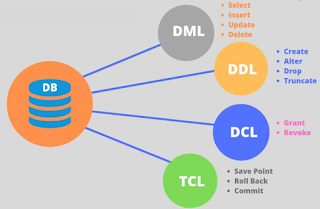Executing DDL and DML Commands
These SQL commands are mainly categorized into four categories as:
DDL:
DML:
DCL:
TCL
- SQL stands for Structured Query Language(SQL).
- It is the database language by the use of which we can perform certain operations on the existing database.
- We can use this language to create a database.
- SQL uses certain commands like Create, Drop, Insert, etc. to carry out the required tasks.
These SQL commands are mainly categorized into four categories as:
- DDL – Data Definition Language
- DML – Data Manipulation Language
- DCL – Data Control Language
- TCL – Transaction Control Language
DDL:
- DDL stands for Data Definition Language.
- DDL consists of the SQL commands that can be used to define the database schema.
- It simply deals with descriptions of the database schema and is used to create and modify the structure of database objects in the database.
- Examples of DDL commands:
- CREATE – is used to create the database or its objects.
- DROP – is used to delete objects from the database.
- ALTER-is used to alter the structure of the database.
- TRUNCATE–is used to remove all records from a table.
- RENAME –is used to rename an object existing in the database.
DML:
- DML stands for Data Manipulation Language.
- The SQL commands that deal with the manipulation of data present in the database.
- Examples of DML:
- INSERT – is used to insert data into a table.
- UPDATE – is used to update existing data within a table.
- DELETE – is used to delete records from a database table.
- SELECT – is used to retrieve data from the database.
DCL:
- DCL stands for Data Control Language.
- DCL includes commands such as GRANT and REVOKE which mainly deals with the rights, permissions and other controls of the database system.
- Examples of DCL commands:
- GRANT-gives user’s access privileges to the database.
- REVOKE-withdraw user’s access privileges given by using the GRANT command.
TCL
- TCL stands for Transaction Control Language
- TCL commands deal with the transaction within the database.
- Examples of TCL commands:
- COMMIT– commits a Transaction.
- ROLLBACK– rollbacks a transaction in case of any error occurs.
- SAVEPOINT–sets a savepoint within a transaction.
- SET TRANSACTION–specify characteristics for the transaction.
Tags:
Java

